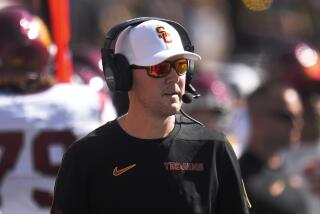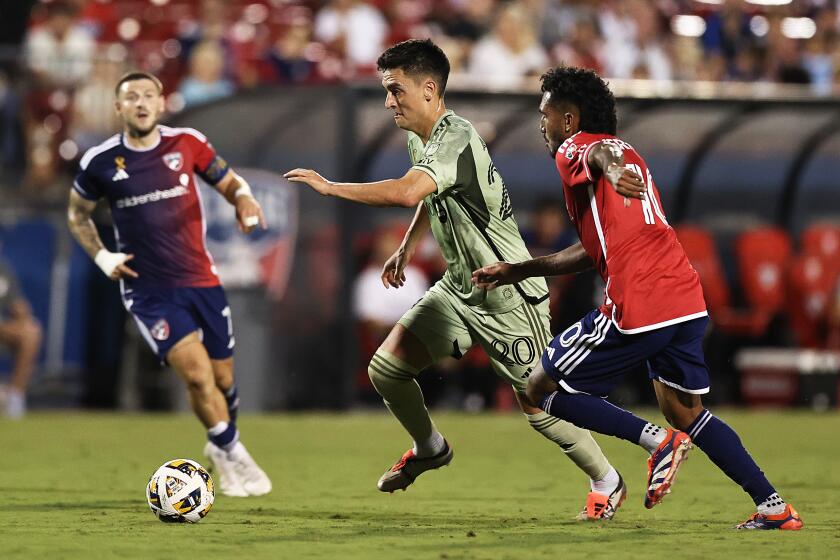Ford was more than met the eye
There was a joke Bob Hope used to tell about playing golf with Gerald Ford and not needing to keep score.
“You just look back along the fairways and count the wounded,” he said.
Hope was referring to the former president’s tendency for hitting errant tee shots that struck spectators at golf tournaments.
Such was the pop culture image of Ford as athlete. Or, more accurately, as klutz.
This notion persisted to his death this week, fed by incidents of slipping on airplane steps and bumping his head against an helicopter doorway. He was parodied by comedian Chevy Chase on “Saturday Night Live,” tripping and fumbling across stage.
The irony is, of all the presidents who might have been cast in this light, Ford had a noteworthy athletic career.
A starting center for Michigan in the early 1930s, he turned down a chance to play professional football. Later, during his political life, he remained an avid tennis player and swimmer.
“He wasn’t klutzy -- that was just a bunch of Democrats talking,” said Al Wistert, a former Michigan player and occasional golf partner. “He was a good athlete.”
His death brought a similar reaction from the Michigan team, in Southern California to face USC in the Rose Bowl on New Year’s Day.
“We all knew he was a great statesman, but we also should remember he was a great athlete,” said Bill Martin, the school’s athletic director.
Ford was an all-state center at Grand Rapids South High in 1930. Then came Michigan, where, in an era before athletic scholarships, he played football and bused tables.
Those first few seasons, he played behind All-American center Charles Bernard. In 1932 and ‘33, the team won consecutive national championships.
When Ford finally got a chance to start as a senior in 1934, Michigan had a woeful squad, finishing 1-7. But he was voted the team’s most valuable player and learned lessons that reached beyond the game.
“A sense of morality and honesty,” said Don Holloway, curator of the Gerald R. Ford Presidential Museum in Grand Rapids. “He learned a sense of culture.”
During that 1934 season, Michigan faced a Georgia Tech team that refused to take the field because the Wolverines had a black player, Willis Ward, on the roster, Holloway said.
Michigan agreed to play without Ward and Ford became so angry that he quit on the spot. Ward appealed to Ford’s sense of responsibility to the team, Holloway said, persuading him to take the field.
That was the only game Michigan won all year.
Though his college career ended on a down note, Ford had played well enough to attract interest from the Detroit Lions and Green Bay Packers, both of whom offered to pay him about $3,000 to join their teams.
Instead, Ford used his athletic background to get hired as a football and boxing coach at Yale, where he was determined to attend law school.
“Once he was there on staff,” Holloway said, “he applied and kept on applying until they accepted him.”
When World War II broke out, Ford joined the U.S. Naval Reserve and worked as a physical fitness instructor at preflight school, then as athletic director aboard the USS Monterey.
Through all of this, Holloway said, the future president learned something else that would come in handy. “It was one of the things he made a point of saying athletics had taught him,” the curator said. “There were any number of people in the stands or in the press who had never thrown a football or played the game, and yet they were all too ready to criticize.”
The jokes started soon after Richard Nixon resigned and Ford was abruptly sworn into office.
Television cameras caught him slipping on the steps of Air Force One and, on another occasion, bumping his head against the door to the presidential helicopter. The media reported on a fall he took while skiing. And then there was the golfing.
Wistert insists that Ford was “an average golfer, and that’s not bad.”
But stories of wayward shots abounded and Hope was there with playful jabs, calling him “the most dangerous driver since Ben-Hur.”
John Robert Greene, a Ford biographer, sees the former president as a product of intersecting dynamics: He was active in various sports, which created more opportunity for missteps, at a time when media coverage was rapidly expanding.
“There was a camera everywhere for these things to happen,” said Greene, a history professor at Cazenovia College in Cazenovia, N.Y.
The quips and criticisms did not seem to deter Ford. He played tennis and tried to swim a mile each day as president. In later years, he stayed active and continued to golf. There was, however, a hint that the constant joking bothered a man who had devoted so much of his life to sports.
“There was no doubt in my mind that I was the most athletic president to occupy the White House in years,” he wrote in his memoir, “A Time to Heal.” “[But] every time I stumbled or bumped my head or fell in the snow, reporters zeroed in on that to the exclusion of almost everything else.”
While Ford could laugh at Chase and “Saturday Night Live,” he worried about the overall perception of him as a bumbler. “And that,” the former Wolverine wrote, “wasn’t funny.”
The Associated Press contributed to this report.
More to Read
Go beyond the scoreboard
Get the latest on L.A.'s teams in the daily Sports Report newsletter.
You may occasionally receive promotional content from the Los Angeles Times.











